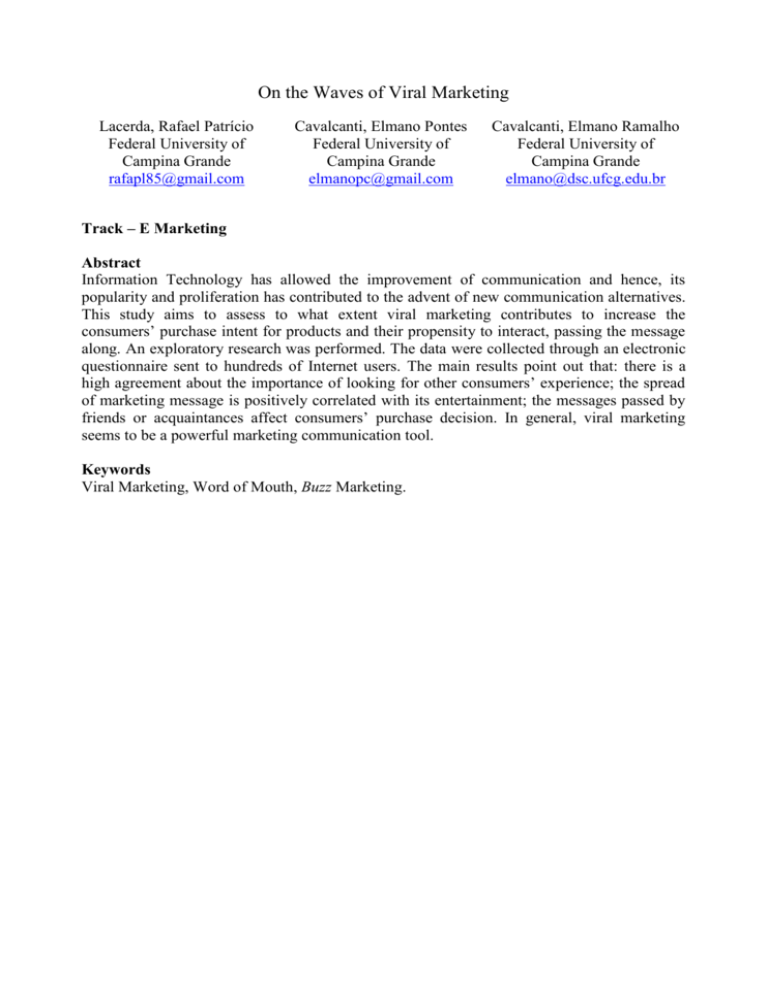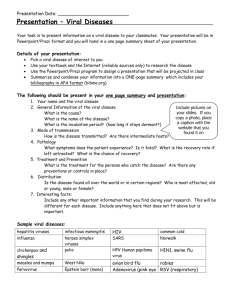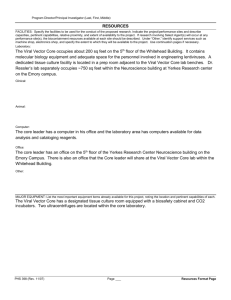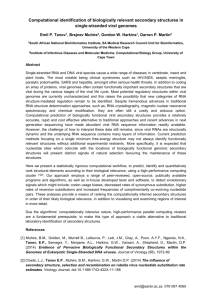On the Waves of Viral Marketing
advertisement

On the Waves of Viral Marketing Lacerda, Rafael Patrício Federal University of Campina Grande rafapl85@gmail.com Cavalcanti, Elmano Pontes Federal University of Campina Grande elmanopc@gmail.com Cavalcanti, Elmano Ramalho Federal University of Campina Grande elmano@dsc.ufcg.edu.br Track – E Marketing Abstract Information Technology has allowed the improvement of communication and hence, its popularity and proliferation has contributed to the advent of new communication alternatives. This study aims to assess to what extent viral marketing contributes to increase the consumers’ purchase intent for products and their propensity to interact, passing the message along. An exploratory research was performed. The data were collected through an electronic questionnaire sent to hundreds of Internet users. The main results point out that: there is a high agreement about the importance of looking for other consumers’ experience; the spread of marketing message is positively correlated with its entertainment; the messages passed by friends or acquaintances affect consumers’ purchase decision. In general, viral marketing seems to be a powerful marketing communication tool. Keywords Viral Marketing, Word of Mouth, Buzz Marketing. 1. Introduction Information Technology has allowed the improvement of communication and hence, its popularity and proliferation has contributed to the advent of new communication alternatives. The main motivation for this is to influence consumers’ choice. The rapid growth of brands is caused due to this phenomenon known as viral marketing (Xiong and Hu, 2010; Pitta, 2008; Cross and Fill, 2008). A great potential associated with this phenomenon is the possibility that ideas, products, messages, and initiatives such as Google’s, Hotmail’s, and Yahoo’s can be spread like viruses. The spread of communication is comparable to a viral epidemic, since the spread of a message can occur exponentially, infecting an increasing number of people in the cyberspace. Acting like a virus, it can spread almost imperceptibly in its initial manifestation, and only be noticeable when the proportion of infected individuals has increased exponentially (Gladwell, 2002). Viral marketing is a powerful tool with a yet untapped potential (Xavier and Summer, 2009), what open possibilities for development of new studies. Thus, this study aims to assess to what extent viral marketing contributes to increase the consumers’ purchase intent for products and their propensity to interact, passing the message along. 2. Viral Marketing Viral marketing is based on the principle of operation of WoM (Word-of-Mouth) and its potential as a tool to generate influence has given rise to a variety of studies concerning effects, influences and impacts resulting from social communication (Brooks, 1958; Stafford, 1966; Ardt, 1967; Engel, Kegerreis and Blackwell, 1969; Richins, 1983; Buttle, 1998). In general, the literature on WoM focuses on three aspects: (1) identify the type of individual who is prone to disseminate experiences; (2) detailing the social networks through which the messages are spread; and (3) to analyze interpersonal influences in the process of searching for information (Brown et al., 2005). The viral communication, unlike spam, is based on the assumption of permission marketing. Viral marketing constitutes an advertising technique in which the digital file is distributed from one user to another via email or social networks (Golan and Zaidner, 2008). It is also considered as tactics to produce a process that allows interested persons involving others (Subramani and Rajagopalan, 2003). Viral marketing is any strategy that can encourage people to spread a marketing message, causing an exponential growth of the message's exposure and influence (Wilson, 2000). Thus, viral marketing can be any marketing activity that accelerates and amplifies the electronic WoM. This phenomenon is the creation of contagious advertising messages or materials that are passed on peer-to-peer (file distribution network), to increase brand awareness (Kirby, 2006). While traditional marketing communication directly addresses the consumer, viral marketing communication develops an environment where consumers send messages without the direct involvement of the original source (Woerndl et al., 2008). The increased level of interest in recent years regarding viral marketing is an indication that there may be significant advantages included in this new marketing technique. The primary advantage of using viral marketing is associated with low cost required to develop the campaign (Kaikati; Kaikati, 2004; Dobele, Toleman, Beverland, 2005; Little, 2005; Kirby, 2006; Fairbank, 2008; Godin 2001). Another important benefit relates to viral marketing is the ability to reach a substantial number of people in a relatively short period of time (Kaikati; Kaikati, 2004; Dobele, Toleman, Beverland, 2005). 3. Methodology The exploratory research used an electronic questionnaire. It was adapted from works of Fairbank (2008), Jakobsen and Skov (2009), and Xavier and Summer (2009). The purpose of the first one was to establish the effectiveness of viral marketing in product sales. The second one sought to understand whether a viral video made by a user is more likely to be passed than the same done by a marketer. The last one aimed to explore the receptivity of consumer, and the perception and behavioral response regarding viral marketing. The questionnaire was divided into three parts. The first part aimed to evaluate the level of consumer engagement for this new media and its tools. The second part aimed to measure the level of the respondents’ attitude concerning advertising in general, and to understand the degree of involvement of the respondent with the chosen product: (digital) cameras. The third part aimed to evaluate the viral video, after watching it. The questions for all the variables are bipolar using a 7 point Likert scale, meaning as follows: 1 ‘disagreement’ and 7 ‘agreement’. This instrument was made available on the Internet, along with the viral video about some ‘S’ brand, worldwide known for its electronic products. For data collection, an invitation email was sent to 600 selected persons, equally distributed between students and professionals from various specialties. The invitation message asked them to take part in the research and, after participating, to indicate other people to be part of the sample. This last point is what characterizes the true meaning of viral marketing. It was used convenient sample. Though it is not representative, it is useful to generate ideas, to get a new overview or to build hypotheses (Malhotra, 2008). Moreover, an auto-generated sample was also used, not by lack of knowledge of the population, but because it resembles the characteristics of viral marketing tactics. Procedures were performed to ensure the reliability of the collected data. The survey was available for twenty-three days. During this period 159 questionnaires were collected, what represents an average of almost 7 questionnaires per day. The response rate was 26.5%. The following guidelines were considered for the analysis of the results: from 1.0 to 2.9 high degree of disagreement, from 3.0 to 4.9 intermediate level, and 5 to 7 high degree of agreement. 4. Findings and discussion The understanding of the level of attitude and perception that people have for sharing information through cyberspace was verified by the following variables: trust in the comments, consumer experience, the effect of comments and messages from friends or acquaintances. Despite the considerable growth of Internet usage by users to express their opinions on many things, there is still some distrust about the source, quality, accuracy and reliability of information posted on the Internet. The level of the trust in the comments was 3.3, which means an intermediate degree between agreement and disagreement. While it is true that the Internet is a plenty source of information and knowledge, it is also true that a portion of them are unreliable. This statement, added to the high incidence of spam messages, may explain the relative lack of confidence by the users. The study conducted by Fairbank (2008) shows that consumers are influenced by online messages, however, they rely more on the opinion written by their friends than by strangers. The effect of comments and messages from friends or acquaintances on the impact of consumers' purchase decision was 4.8. It is believed that the loss of negative feedback is greater than the benefit of positive feedback, since the motivation for the WoM is greater in the first case (Kottler and Keller, 2006). However, this certain mistrust about the comments and messages does not prevent searching for other consumers’ experience. There was a high agreement (6.4) about the importance of seeking the experience of other consumers. This suggests that one of the basic prerequisites for the consumer's purchase decision is the opinion of people who have bought and used the product. These results emphasize the relevance of WoM, partly because the value found for comments and messages from friends or acquaintances, which sought to understand the extent to which the comments and messages passed by friends or acquaintances affect consumers’ purchase decision, was also at high level of concordance (6.0). Thus, from a consumer perspective, the contribution to the growth of WoM and viral marketing may stem mainly from: the suffering caused by negative experiences and a concern to avoid future suffering. These results indeed reinforce the growth of efforts toward the WoM and viral marketing, since they can provide a greater impact on the consumer than the traditional marketing communication tools. The attitude with respect to the video was inspected through the variables perception of the video, opinion of the video, innovation, creativity, and entertainment. Thus, the purpose was to understand the level of impact that the viral video used in the experiment caused on consumer perceptions. The purpose of perception of the video was to know if the video was considered of good quality. The result was 5.7, indicating high concordance. This may mean that the video has attracted attention, and thus be well rated. This type of advertising differs considerably from traditional advertisements. Attracting consumer attention to something not so serious, but that may generate a curiosity in the viewer for seeking more information, and to make comments that possibly arouse other people’s interest. The opinion of the video was 5.7, indicating a good level. What may have happened to this result be not higher? The modus operandi of viral marketing is different to that involving traditional communication and this requires adaptations and new learning by the marketing professional. The video was also assessed in terms of innovation (5.8), creativity (6.1), and entertainment (5.6). These results mean that the video was considered innovative, creative, and also provide good entertainment. The new tools of information technology and the usage of viral marketing may already suggest a kind of innovation. To enable the occurrence of viral effect, the video needs some kind of innovation, creativity, and entertainment. These key features are intrinsic to viral videos, whether they are in the form of product presentation, interaction with viewers, attracting attention, generating questions, etc. It is interesting to note that the foreground of a viral video is within these characteristics. The highlight would be for entertainment, creativity and innovative aspect. Meanwhile, the brand or the product may appear in a subtle way in the background. Thus, consumers may not associate the video with the advertisement and thus feel encouraged to spread it. Video content was verified through the use of information, relevance of information and importance of information. The results (respectively 5.2, 5.1 and 5.1) suggest the video was considered useful, relevant and important. Despite these results, there were some divergent manifestations of the respondents: "the video does not show any kind of information I consider relevant", "the video shows good creativity, but not enough to be very fun". Comments like these show the level of complexity and the requirement that the marketer has to deal to find a balance between the key attributes and the volume of information. Among the favorable manifestations of respondents are: “since it is self-explanatory, it shows several important questions”, “it is interactive, interesting and conveys product quality and value”. For presenting these characteristics, the respondent said that would spread the video. Comments like this highlight the potential that a viral video can help on strengthening a brand. These statements may suggest that the developer of the video needs to define in advance how to express the message and the essence of its content. This step is important because the effectiveness of viral marketing depends on the reaction of the viewer to the displayed content. If the viewer likes it, there is a considerable possibility of passing it to others. The video quality was measured by the perception on the quality and level of professionalism. The results were respectively 5.4 and 5.3. Among the respondents' comments: "It is expected a quality and impressive advertising coming from the S brand", "the video quality is a fundamental attribute, because if you leave a bad impression, especially for a known brand, people probably will not reproduce the video in cyberspace". Thus, besides being one of the key factors for the dissemination, the video quality can provide positive or negative associations to the brand. Regarding the level of professionalism, one respondent said: "At the beginning of the video you think it is amateur, not associating an advertisement, then you see that its real intention is to promote the X camera". The aim with this strategy is to make the video different from a typical commercial, which represents one of the main characteristics of viral marketing. Jakobsen and Skov (2009) conducted an experiment with two videos related to two brands. The first (Nike) was developed by a user and the other (Sprite) by a professional. They concluded that, whatever people believe that the advertisements are created by Internet users or marketers, the quality requirement is apparently present in consumer perception. Thus, whether the video creator is or not a professional, a viral video needs to show creativity, quality, information and context so that the brand is identified and stored, as well as the content must be compelling enough to disseminate it. The tendency to pass the message forward was examined by the impetus to spread and spread of marketing message. The results were respectively 4.6 and 4.9, suggesting certain apprehension to pass the message forward. This was evidenced in the following comment: "I would spread the video if I’d gain from this. Failing that, only in cases where the context of the conversation with my friends were like the example of the video". Comments like this demonstrate that, to achieve the desired effect is not an easy task for viral marketing. Being funny, having a bit of humor or entertainment may not be enough. Although not presenting an immediate effect, it is possible that the video could leave some underlying feeling in the viewer's memory and thrive in a timely manner (Witz and Chew, 2002). Independently the effect is immediate or not, an interesting question arises: will the consumer talk about the video or the brand? In this sense it was found that the spread of marketing message is positively correlated with a significance level of 0.01 with the video entertainment. Respectively, the values for tests of Pearson, Spearman and Kendall were: r = 0.604, rho = 0.501 and tau-b = 0.581. The strength of this relationship varies between moderate and strong. Overall, these results mean that, ceteris paribus, the video would stand out above the brand. Related to this, the volume of consumers’ feedback is positively correlated with the volume of sales (Godes and Mayzlin, 2004; Dellarocas et al., 2007). However, if the video stands out above the brand, it does not mean that this wouldn’t be interesting for the brand. It is noteworthy that however much the attributes highlight the video and this gets the focus of attention, the brand will inevitably be associated with it. As a result of curiosity the brand will be indirectly benefited. Once a person has opted to pass the message forward, it remains for the consumer to choose the recipients. It should be noted that potential senders tend to be selective in that choice (Phelps et al., 2004). As a final verification of attitude, the propensity to buy was used to assess how far the video has sparked consumer's purchase intention. The result was 4.6. Although this value does not characterize a good propensity for the purchase and probably does not ensure the increment of sales for the S brand, it can contribute to a latent effect and cause positive consequences at a later time. According to Blackwell, Miniard and Engel (2005), the consumer’s attitude comes under the influence of beliefs about the attributes of a product. For example, the viral video about the camera captures consumer’s attention by humor, causing a processing of the viewed information. After that, the interest for the product just arises, through the belief that the camera will provide perfect images, and additional resources. Thus, the consumer makes a “mental note”, reminding him to search for information about the product until he believes that will like the camera enough to try it or acquire it. 5. Conclusions From the observed results, although there is some suspicion in the messages from viral marketing waves, the consumer seems to be convinced of the importance of seeking other consumers’ experiences. As already recognized by several studies, the greater effectiveness of a message, when sent by friends or acquaintances, could also be observed in this study. Although the video has caused a purchase intention, a number of other factors (e.g., personal, product or context), also contribute to this. Anyway, the influence of the marketing message to affect consumers’ purchase decision can explain the growing efforts toward WoM, viral marketing and even social networks. Among the key motivating factors that lead consumers to disseminate messages are those related to the entertainment provided by the advertisement and selflessness to help other consumers. The attributes of innovation, creativity, entertainment and quality could emphasize the video over the brand. Nevertheless, the brand will inevitably be associated with it. Finally, not achieving a high propensity for purchasing does not preclude the use of viral marketing. Though the stimulus provided by the marketing message is low and implies no instantly effect, it may happen in a moment later. In general, viral marketing seems to be a powerful marketing communication tool. The following items are suggest as future research: to search for possible differences between the purchase intention and its realization; to examine to what extent companies are actually prepared to use this new tool; to propose a model for measuring effectiveness of viral marketing; and to propose a model to identify individuals more likely for spreading the marketing message. References Arndt, J. (1967). Role of Product-Related Conversations in the Diffusion of a New Product. Journal of Marketing Research, 4, 291-295. Blackwell, R.D., Miniard, W. & Engel, J.F. (2005). Consumer Behavior. Boston: Thomson South Westerns. Buttle, F.A. (1998). Word-of-mouth: understanding and managing referral marketing. Journal of Strategic Marketing, 6 3, 241-254. Brooks, R. C. (1858). Word-of-Mouth adverstising in selling new products. Journal of Marketing, 22, 154-161. Brown, T.J. et. al. (2005). Spreading the word: investigating antecedents of consumers' positive word-of-mouth intentions and behaviors in a retailing context. Journal of the Academy of Marketing Science, 33, 2, 123-138. Cruz, D. & Fill, C. (2008). Evaluating viral marketing: isolating the key criteria. Marketing Intelligence & Planning, 26 7, 743-758. Dellarocas, C., Xiaoquan, Z. & Awad, N.F. (2007). Exploring the value of online product reviews in forecasting sales: the case of motion pictures. Journal of Interactive Marketing, 21, 4, 23-45. Dobele, A. et al. (2007). Why pass on viral messages? Because they connect emotionally. Business Horizons, 50, 291-304. Dobele, A., Toleman, D. & Beverland, M. (2005). Controlled infection! Spreading the brand message through viral marketing. Business Horizons, 48, 2, 143-149. Engel, J.F., Kegerreis, R.J. & Blackwell, R.D. (1969). Word-of-mouth communication by the innovator. Journal of Marketing, 33, 15-19. Fairbank, V. (2008). A study into the effectiveness of viral marketing over the internet (Dissertation), Retrieved from http://mmedia.glos.ac.uk/mu303/MU303331%20Project_files/MU303_08_FairbankV.pdf Gladwell, M. (2002). The Tipping Point: How Little Things Can Make a Big Difference. Boston: LBC. Godes, D. & Mayzlin, D. (2004). Using online conversations to study word-of-mouth communications. Marketing Science, 23, 4, 545-560. Golan, G.J. & Zaidner, L. (2008). Creative Strategies in Viral Advertising: An Application of Taylor’s Six-Segment Message Strategy Wheel. Journal of Computer-Mediated Communication, 13, 959-972. Hennig-Thurau, T. et. al. (2004). Electronic Word-of-Mouth Via Consumer-Opinion Platforms: What Motivates Consumers to Articulate Themselves on the Internet?. Journal of Interactive Marketing, 18 1, 38-52. Jakobsen, J. & Skov, H. (2009). User created Ads in viral marketing (Thesis), Retrieved from Kaikati, A.M, & Kaikati, J.G. (2004). How to reach consumers surreptitiously. California Management Review, 46 4, 6-22. Kirby, J. (2006). Viral Marketing. In Justin Kirby and Paul Marsden, Connected Marketing: The Viral, Buzz and Word of Mouth Revolution, Butterworth Heinemann, Oxford, England, 87-106. Kotler, P. & Keller, K. (2006). Marketing management. Englewood Cliffs: Prentice Hall. Malhotra, N.K. (2008). Basic Marketing Research. Englewood Cliffs: Prentice Hall. Phelps, J.E. et. al. (2004). Viral Marketing or Electronic Word-of-Mouth Advertising: Examining Consumer Responses and Motivations to Pass Along Email. Journal of Advertising Research, 44 4, 333-348. Pitta, D. (2008). Providing the tools to build brand share of heart: Gydget.com. Journal of Product & Brand Management, 26 7, 743-758. Richins, M.L. (1983). Negative word-of-mouth by dissatisfied customers: a pilot study. Journal of Marketing, 47, 68-78. Stafford, J.E. (1966). Effects of Group Influences on Consumer Brand Preferences. Journal of Marketing Research, 3, 68-75. Subramani, M.R & Rajagopalan, B. (2003). Knowledge-sharing and influence in online social networks via viral marketing. Communications of the ACM, 46 12, 300-307. Wilson, R. F. (2000). The six simple principles of viral marketing. Web Marketing Today, 70, 1-3. Wirtz, J. & Chew, (2002). The effects of incentives, deal proneness, satisfaction and tie strength on word-of-mouth behavior. International Journal of Service Industry Management, 13 2, 141-162. Woerndl, M. et. al. (2008). Internet-induced marketing techniques: critical factors in viral marketing campaigns. Int. Journal of Business Science and Applied Management, 3 1, 34-45. Xavier, L.J.W. & Summer, G.Y.S. (2009). Viral marketing Communication: the internet word-of-mouth (Thesis), Retrieved from http://www.btu.se/fou/cuppsats.nsf/all/16a910ef2f515005c1257610003e334f/$file/Viral_Mar keting_Communication-A_study_on_consumer_perception_and_response.pdf Xiong, L. & Hu, C. (2010). Harness the power of viral marketing in hotel industry: a network discount strategy. Journal of Hospitality and Tourism Technology, 1 3, 234-244.





